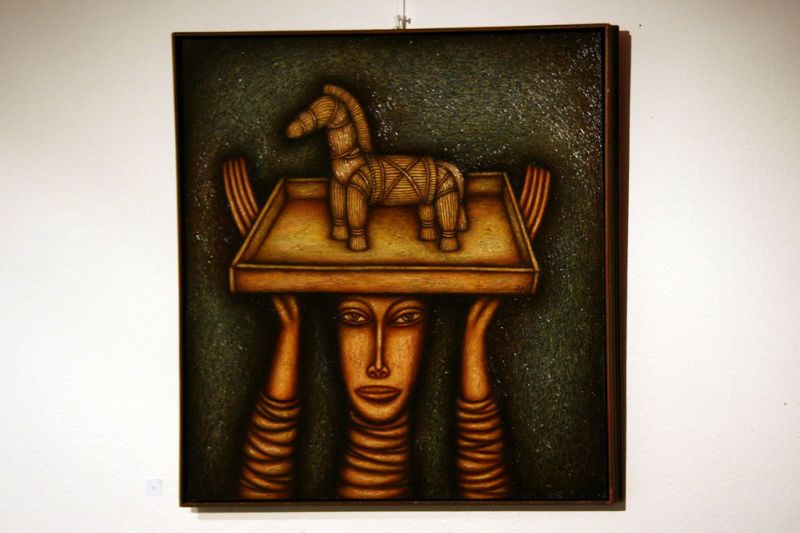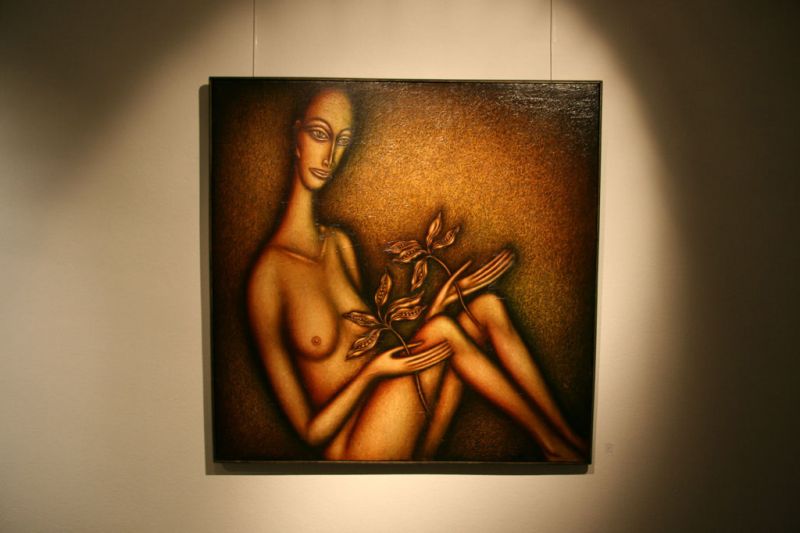Aleksandr Grechanik Grigorevitch, 1955 in Moskau geboren, zählt zu den bedeutensten Künstlern der berühmten ‘Malaya Grouzinskaya’ aus der russischen Vor-Perestroyka Periode. Schon als Schüler stellte er sein Talent unter Beweis und fand große Anerkennung. 1978 besuchte Aleksandr Grechanik die Kunstakademie in Moskau und wurde rasch zu einem „Star“ unter den jungen KünstlerInnen. Das damals herrschende System und die politische Situation Russlands unterdrückte aber lange Zeit das freie Arbeiten von Aleksandr Grechanik. Strenge Partei-Vorgaben und harte Sanktionen gegen nicht konforme Arbeiten und Gedanken trieben die jungen KünsterInnen in eine Untergrundbewegung. Er zog sich auch aus dieser Bewegung zurück, um sich der permanenten politischen Reflektion zu entziehen und sich in seiner Arbeit anderen Themen zu widmen.
Seiner Arbeiten wurden unter andern von der »Moskau Union von Rußlands Malern«, der »Union von Rußlands Malern« sowie der »Internationalen UNESCO Künstlergemeinschaft« honoriert.
Bilder der Ausstellung


















It is not difficult to master the very art of painting. The technique of brush and oil could be passed from a specialist to a student in a few years of hard work. The problem is to find one’s own technique, to create the specific recognizable world of one’s own paintings. Technique is not enough. The pavement artist with chalks can create such nice images on the street that the innocent observer may think: what could be more like the reality? Is it not the task of the artist to create images as close to reality as possible? The more experienced person may argue: the task of the real artist is to create the image most differing from reality. The whole spectrum of art works has to be somewhere in between from the most close imitation of the reality to the wild hallucination’s images of ill fantasy. This maybe is a very narrow approach to the problem but this is true. Especially for Russia.
Aleksandr Grechanik Grigorevitch, Artist, Russia

Alexander Grechanik is a Russian artist grown up in soviet epoch of ‘communism’. This gave him a unique opportunity to obtain the mastery of technique of painting which is rarely possible in other places of the world even now. The skewed soviet system provided in some cases extremely good results – education was one of such. Alexander since first days of his art life being still a student of the prestigious art institute paid attention to technical mastery, ancient art traditions, ‘secrets of old masters’ which could still be obtained through survived painters who still recalled and worked with such giants as Malevich, Kandinsky, Petrov-Vodkin… The flourished school of antique restoration lead by Grabar added a strong professionalism in work with materials, natural colors, pigments, techniques of multi-layer oil painting and other rare skills. Alexander masters this with excellent results but this was not the reason for being marked as one of the most promising students. After all, there were many of such who could do such things. Alexander at the very beginning was put into the vice circle of soviet system: either a painter create works which suite the official representatives from Party control organs or comes to ‘underground’ club. Both ways were not suitable for Grechanik because both were only the reflection of this world political life. And Grechanik’s interests were in other perspective. He begin to work as a technical artist, designer, earning money by big orders where the work was purely professional and out of political stream. At the same time he works literally through day and night – not trying to find his own way, this he found at the very beginning of his path – trying to find the way to present his own world of fantasy and reality by all the technical means he mastered. This was not easy. This was an attempt to levitate over reality at the same time being inside this reality. The reality which crushed those who has chosen the alternative paths in art by bulldozers. Alexander was a participant of the famous ‘Malaya Grouzinskaya’ art community in early pre-perestroyka period. And still for him it was not enough. The topics, problems and themes which were popular and brought money at that time were too flat and shallow. We recall that period. It was enough to make a portrait of Lenin in a grotesque form or add sickle and red star to an icon or Christ image to some Party collage – and it was well bought, well praised and very nice for establishing an image of opposition and very brave artist. Thousands of people in Kremlin Manage stood for hours in a frost to see the paintings of Stalin on a blood carpet and Russian-stylized prophets painted by Ilya Glazunov. This was not the way of master in Grechanik’s understanding. Only very few of masters put into the same cultural conditions and political environment: Oleg Tselkov, Vadim Sidur, Ernst Neizvestny – persons like these preserved their ability to find a fame and own path through this turbulent situation. Alexander Grechanik just then began to create works which were out of lines of any political situation, out of this real world – and at the same time more real in time frames than the works of hundreds of painters who got their money to be lost in few decades. It is not that Alexander was not famous and did not earn money. It is always easy to tell: I am so different that nobody understands me. So they do not buy. Yes, they bought. But we have to look who bought his works and why.